The Barrier Inhomogeneity and the Electrical Characteristics of W/Au β-Ga2O3 Schottky Barrier Diodes
Abstract
1. Introduction
2. Device Structure and Process
3. Results and Discussion
4. Conclusions
Author Contributions
Funding
Data Availability Statement
Conflicts of Interest
References
- Cassabois, G.; Valvin, P.; Gil, B. Hexagonal boron nitride is an indirect bandgap semiconductor. Nat. Photonics 2016, 10, 262–266. [Google Scholar]
- Hickman, A.L.; Chaudhuri, R.; Bader, S.J.; Nomoto, K.; Li, L.; Hwang, J.C.M.; Grace Xing, H.; Jena, D. Next generation electronics on the ultrawide-bandgap aluminum nitride platform. Semicond. Sci. Technol. 2021, 36, 044001. [Google Scholar]
- Xie, L.; Xu, S.; Zhang, T.; Tao, H.; Su, H.; Gao, Y.; Liu, X.; Zhang, Y.; Zhang, J.; Hao, Y. Improved crystal quality of β-Ga2O3 on sapphire (0001) substrates by induced-nucleation technique and enhancement of Ga2O3 UV photodetectors performance. J. Alloys Compd. 2025, 1016, 178924. [Google Scholar]
- Sasama, Y.; Kageura, T.; Imura, M.; Watanabe, K.; Taniguchi, T.; Uchihashi, T.; Takahide, Y. High-mobility p-channel wide-bandgap transistors based on hydrogen-terminated diamond/hexagonal boron nitride heterostructures. Nat. Electron. 2022, 5, 37–44. [Google Scholar]
- Butenko, P.N.; Boiko, M.E.; Guzilova, L.I.; Krymov, V.M.; Shapenkov, S.V.; Sharkov, M.D.; Verbitskii, V.N.; Zarichny, A.A.; Nikolaev, V.I. Enhancing the perfection of bulk (100) β-Ga2O3 crystals grown by Czochralski method. J. Cryst. Growth 2024, 630, 127597. [Google Scholar]
- Sheoran, H.; Kumar, V.; Singh, R. A Comprehensive Review on Recent Developments in Ohmic and Schottky Contacts on Ga2O3 for Device Applications. ACS Appl. Electron. Mater. 2022, 4, 2589–2628. [Google Scholar]
- Ahmed, S.S.; Islam, A.E.; Dryden, D.M.; Liddy, K.J.; Hendricks, N.S.; Moser, N.A.; Chabak, K.D.; Green, A.J. Theoretical Power Figure-of-Merit in β-Ga2O3 Lateral Power Transistors Determined Using Physics-Based TCAD Simulation. IEEE Trans. Electron Devices 2024, 71, 5305–5312. [Google Scholar]
- Zhang, J.; Li, X.; Zhu, R.; Wang, K.; Zhang, B.; Zhang, C. Low loss and low EMI noise trench IGBT with shallow emitter trench controlled p-type dummy region. Chin. J. Electron. 2024, 33, 326–335. [Google Scholar]
- Liu, A.-C.; Hsieh, C.-H.; Langpoklakpam, C.; Singh, K.J.; Lee, W.-C.; Hsiao, Y.-K.; Horng, R.-H.; Kuo, H.-C.; Tu, C.-C. State-of-the-Art β-Ga2O3 Field-Effect Transistors for Power Electronics. ACS Omega 2022, 7, 36070–36091. [Google Scholar]
- Li, X.; Jiang, W.; Wang, Y.; Zhang, H.; Peng, C.; Zhang, X.; Liang, X.; Fu, W.; Zhang, Z.; Lei, Z.; et al. Single-event burnout in β-Ga2O3 Schottky barrier diode induced by high-energy proton. Appl. Phys. Lett. 2024, 125, 092101. [Google Scholar]
- Green, A.J.; Speck, J.; Xing, G.; Moens, P.; Allerstam, F.; Gumaelius, K.; Neyer, T.; Arias-Purdue, A.; Mehrotra, V.; Kuramata, A.; et al. β-Gallium oxide power electronics. APL Mater. 2022, 10, 029201. [Google Scholar] [CrossRef]
- Green, A.J.; Chabak, K.D.; Baldini, M.; Moser, N.; Gilbert, R.; Fitch, R.C.; Wagner, G.; Galazka, Z.; Mccandless, J.; Crespo, A.; et al. β-Ga2O3 MOSFETs for Radio Frequency Operation. IEEE Electron Device Lett. 2017, 38, 790–793. [Google Scholar] [CrossRef]
- Wong, M.H. A landscape of β-Ga2O3 Schottky power diodes. J. Semicond. 2023, 44, 091605. [Google Scholar] [CrossRef]
- Gammon, P.M.; Pérez-Tomás, A.; Shah, V.A.; Vavasour, O.; Donchev, E.; Pang, J.S.; Myronov, M.; Fisher, C.A.; Jennings, M.R.; Leadley, D.R.; et al. Modelling the inhomogeneous SiC Schottky interface. J. Appl. Phys. 2013, 114, 223704. [Google Scholar] [CrossRef]
- Splith, D.; Müller, S.; Schmidt, F.; von Wenckstern, H.; van Rensburg, J.J.; Meyer, W.E.; Grundmann, M. Determination of the mean and the homogeneous barrier height of Cu Schottky contacts on heteroepitaxial β-Ga2O3 thin films grown by pulsed laser deposition. Phys. Status Solidi A 2014, 211, 40–47. [Google Scholar] [CrossRef]
- Greco, G.; Giannazzo, F.; Fiorenza, P.; Di Franco, S.; Alberti, A.; Iucolano, F.; Cora, I.; Pecz, B.; Roccaforte, F. Barrier Inhomogeneity of Ni Schottky Contacts to Bulk GaN. Phys. Status Solidi A 2018, 215, 1700613. [Google Scholar] [CrossRef]
- Lee, K.Y.; Huang, Y.H. An Investigation on Barrier Inhomogeneities of 4H-SiC Schottky Barrier Diodes Induced by Surface Morphology and Traps. IEEE Trans. Electron Devices 2012, 59, 694–699. [Google Scholar] [CrossRef]
- Yadav, M.K.; Mondal, A.; Sharma, S.K.; Bag, A. Unveiling Thermal Effects on Sn-Doped β-Ga2O3 Schottky Barrier Diodes on Sapphire for High-Temperature Power Electronics. IEEE Trans. Electron Devices 2024, 71, 1529–1534. [Google Scholar] [CrossRef]
- Hou, C.; Gazoni, R.M.; Reeves, R.J.; Allen, M.W. Oxidized Metal Schottky Contacts on (010) β-Ga2O3. IEEE Electron Device Lett. 2019, 40, 337–340. [Google Scholar] [CrossRef]
- Taşçıoğlu, İ.; Aydemir, U.; Altındal, Ş. The explanation of barrier height inhomogeneities in Au/n-Si Schottky barrier diodes with organic thin interfacial layer. J. Appl. Phys. 2010, 108, 064506. [Google Scholar] [CrossRef]
- Triendl, F.; Pfusterschmied, G.; Pobegen, G.; Konrath, J.P.; Schmid, U. Theoretical and experimental investigations of barrier height inhomogeneities in poly-Si/4H-SiC heterojunction diodes. Semicond. Sci. Technol. 2020, 35, 115011. [Google Scholar]
- Reddy, P.R.S.; Janardhanam, V.; Shim, K.-H.; Reddy, V.R.; Lee, S.-N.; Park, S.-J.; Choi, C.-J. Temperature-dependent Schottky barrier parameters of Ni/Au on n-type (001) β-Ga2O3 Schottky barrier diode. Vacuum 2020, 171, 109012. [Google Scholar]
- Higashiwaki, M.; Konishi, K.; Sasaki, K.; Goto, K.; Nomura, K.; Thieu, Q.T.; Togashi, R.; Murakami, H.; Kumagai, Y.; Monemar, B.; et al. Temperature-dependent capacitance–voltage and current–voltage characteristics of Pt/Ga2O3 (001) Schottky barrier diodes fabricated on n-–Ga2O3 drift layers grown by halide vapor phase epitaxy. Appl. Phys. Lett. 2016, 108, 133503. [Google Scholar]
- Hou, C.; Gazoni, R.M.; Reeves, R.J.; Allen, M.W. Dramatic Improvement in the Rectifying Properties of Pd Schottky Contacts on β-Ga2O3 During Their High-Temperature Operation. IEEE Trans. Electron Devices 2021, 68, 1791–1797. [Google Scholar]
- Iucolano, F.; Roccaforte, F.; Giannazzo, F.; Raineri, V. Barrier inhomogeneity and electrical properties of Pt/GaN Schottky contacts. J. Appl. Phys. 2007, 102, 113701. [Google Scholar]
- Garg, M.; Naik, T.R.; Pathak, C.S.; Nagarajan, S.; Rao, V.R.; Singh, R. Significant improvement in the electrical characteristics of Schottky barrier diodes on molecularly modified Gallium Nitride surfaces. Appl. Phys. Lett. 2018, 112, 163502. [Google Scholar]
- Qian, L.-X.; Wu, Z.-H.; Zhang, Y.-Y.; Lai, P.T.; Liu, X.-Z.; Li, Y.-R. Ultrahigh-Responsivity, Rapid-Recovery, Solar-Blind Photodetector Based on Highly Nonstoichiometric Amorphous Gallium Oxide. ACS Photonics 2017, 4, 2203–2211. [Google Scholar]
- Mi, W.; Ma, J.; Luan, C.; Xiao, H. Structural and optical properties of β-Ga2O3 films deposited on MgAl2O4 (100) substrates by metal–organic chemical vapor deposition. J. Lumin. 2014, 146, 1–5. [Google Scholar]
- Polyakov, A.; Lee, I.-H.; Smirnov, N.; Shchemerov, I.; Vasilev, A.; Chernykh, A.; Pearton, S. Electric field dependence of major electron trap emission in bulk β-Ga2O3: Poole–Frenkel effect versus phonon-assisted tunneling. J. Phys. D Appl. Phys. 2020, 53, 304001. [Google Scholar]
- Yao, Y.; Davis, R.F.; Porter, L.M. Investigation of Different Metals as Ohmic Contacts to β-Ga2O3: Comparison and Analysis of Electrical Behavior, Morphology, and Other Physical Properties. J. Electron. Mater. 2017, 46, 2053–2060. [Google Scholar]
- Zhang, T.; Lee, C.-Y.; Gong, B.; Lim, S.; Wenham, S.; Hoex, B. In situ x-ray photoelectron emission analysis of the thermal stability of atomic layer deposited WOx as hole-selective contacts for Si solar cells. J. Vac. Sci. Technol. A 2018, 36, 031601. [Google Scholar]
- Chen, W.-J.; Ma, H.-P.; Gu, L.; Shen, Y.; Yang, R.-Y.; Zhang, J.; Yang, L.; Zhu, J.; Zhang, Q.-C. Influence of nitrogen annealing treatment on optical, microstructural, and chemical properties of Ga2O3 film grown by plasma-enhanced atomic layer deposition. J. Phys. Chem. C 2023, 127, 10688–10698. [Google Scholar]
- Gao, S.; Yang, X.; Cheng, J.; Guo, X.; Kang, R. Deformation and fracture behaviors of monocrystalline β-Ga2O3 characterized using indentation method and first-principles calculations. Mater. Charact. 2023, 200, 112920. [Google Scholar]
- Hong, Y.; Zheng, X.; He, Y.; Liu, K.; Zhang, H.; Wang, X.; Yuan, Z.; Zhang, F.; Wang, Y.; Ma, X.; et al. Enhancing performance of β-Ga2O3 diodes through a NixO/SiNx/Ga2O3 sandwich structure. J. Alloys Compd. 2024, 976, 173062. [Google Scholar]
- Wang, Z.; Gong, H.-H.; Yu, X.-X.; Ji, X.; Ren, F.-F.; Yang, Y.; Gu, S.; Zheng, Y.; Zhang, R.; Ye, J. Trap-mediated bipolar charge transport in NiO/Ga2O3 p+-n heterojunction power diodes. Sci. China Mater. 2023, 66, 1157–1164. [Google Scholar] [CrossRef]
- Xian, M.; Fares, C.; Ren, F.; Gila, B.P.; Chen, Y.-T.; Liao, Y.-T.; Tadjer, M.; Pearton, S.J. Effect of thermal annealing for W/β-Ga2O3 Schottky diodes up to 600 °C. J. Vac. Sci. Technol. B 2019, 37, 061201. [Google Scholar]
- Chen, J.; Bian, Z.; Liu, Z.; Zhu, D.; Duan, X.; Wu, Y.; Jia, Y.; Ning, J.; Zhang, J.; Hao, Y. Effects of thermal annealing on the electrical and structural properties of Mo/Au schottky contacts on n-GaN. J. Alloys Compd. 2021, 853, 156978. [Google Scholar]
- Tung, R.T. Electron transport at metal-semiconductor interfaces: General theory. Phys. Rev. B 1992, 45, 13509–13523. [Google Scholar]
- Subhash, C.; Jitendra, K. Simulation and analysis of the I-V characteristics of a Schottky diode containing barrier inhomogeneities. Semicond. Sci. Technol. 1997, 12, 899. [Google Scholar]
- Chand, S.; Kumar, J. Effects of barrier height distribution on the behavior of a Schottky diode. J. Appl. Phys. 1997, 82, 5005–5010. [Google Scholar]
- Pakma, O.; Serin, N.; Serin, T.; Altındal, Ş. The double Gaussian distribution of barrier heights in Al/TiO2/p-Si (metal-insulator-semiconductor) structures at low temperatures. J. Appl. Phys. 2008, 104, 014501. [Google Scholar] [CrossRef]

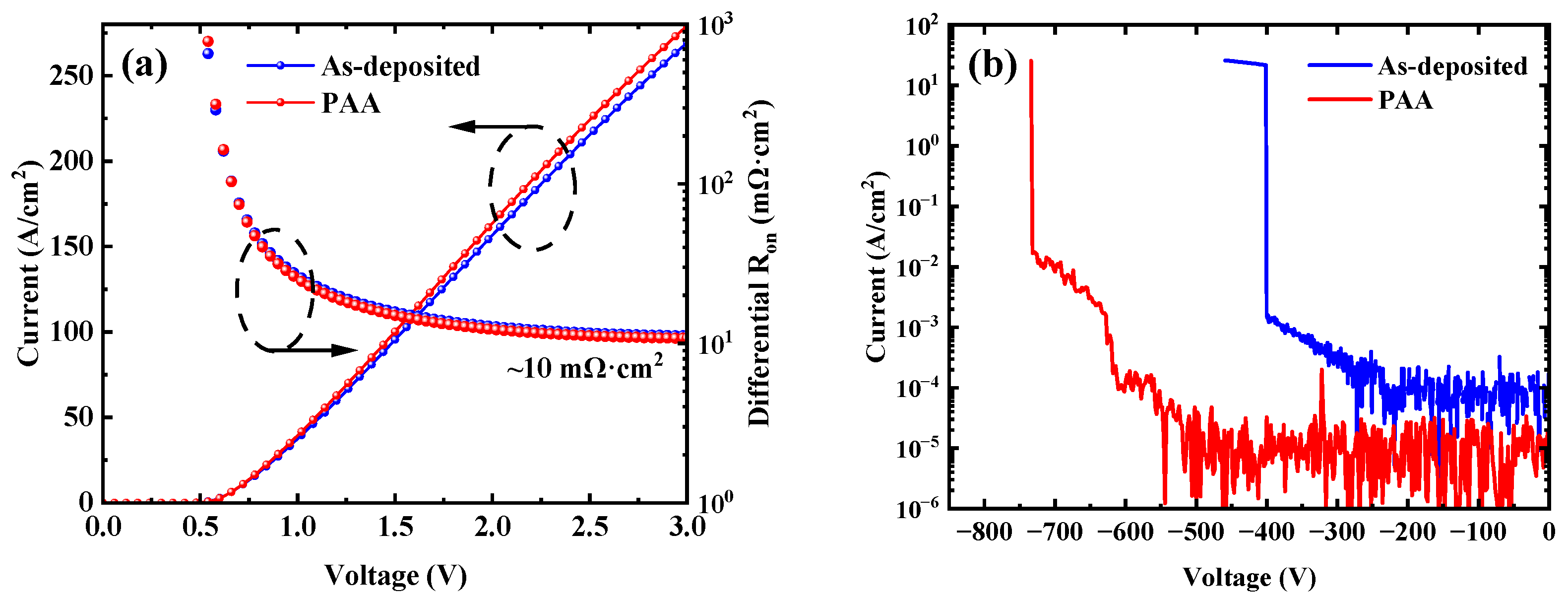
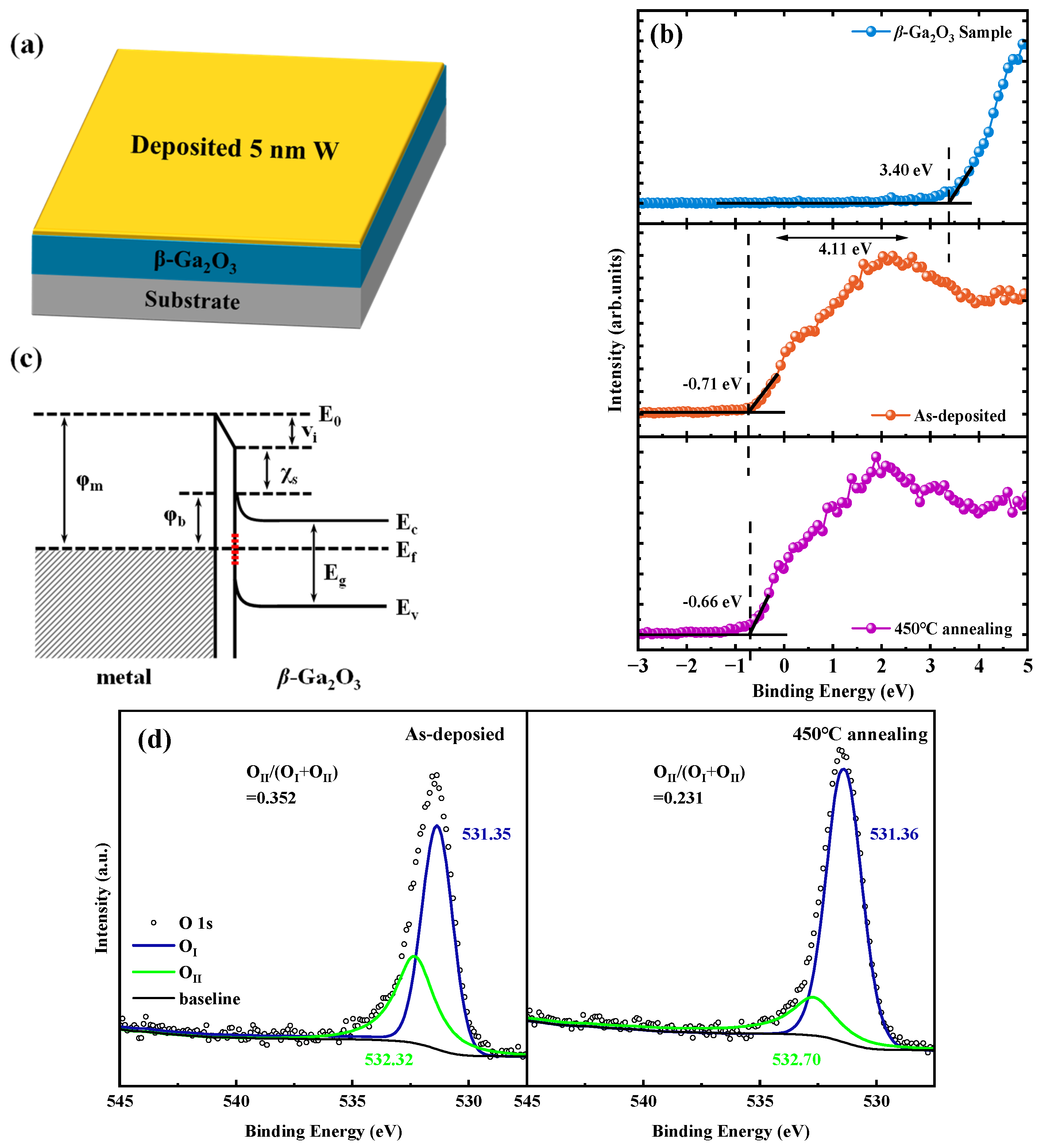
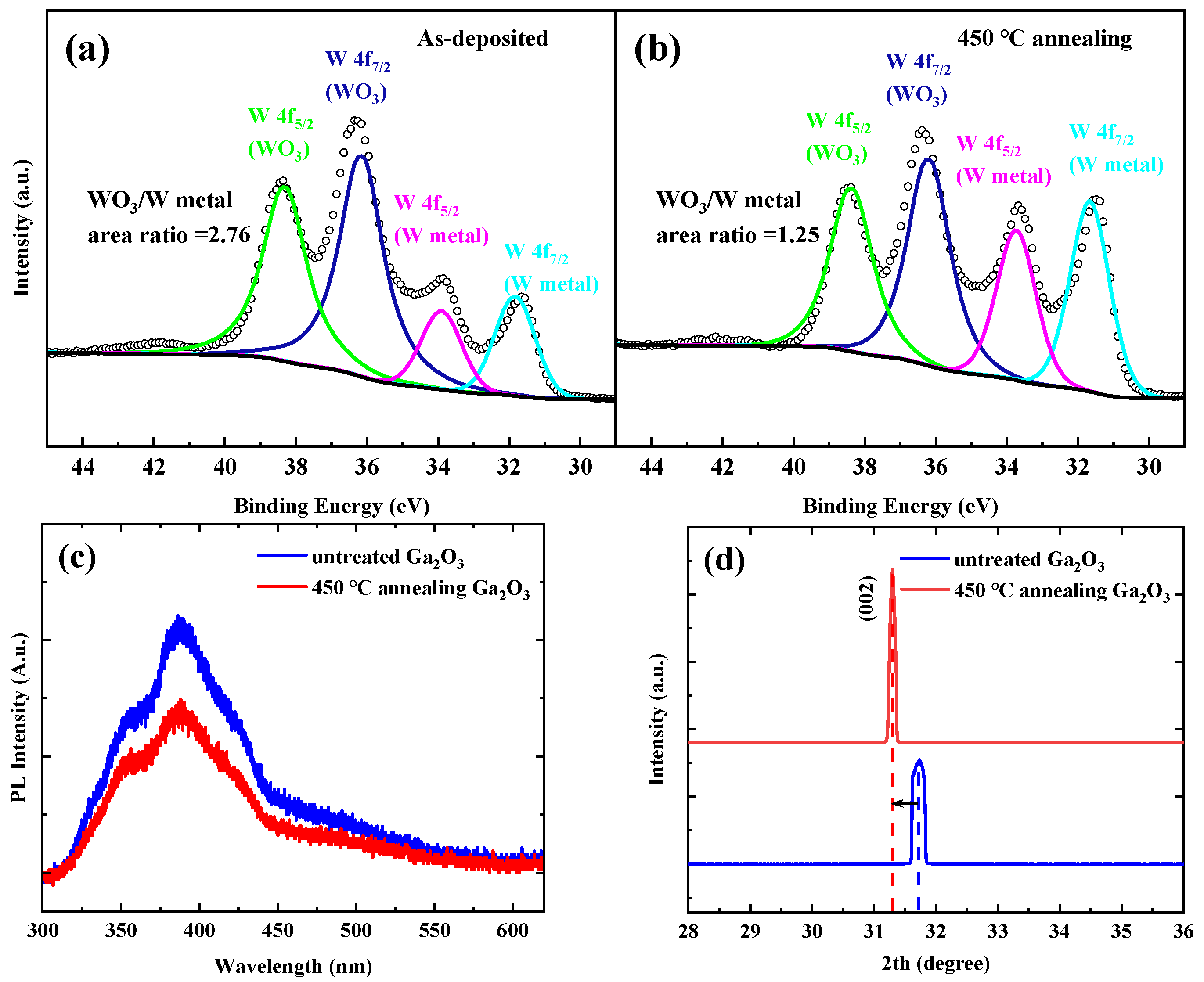
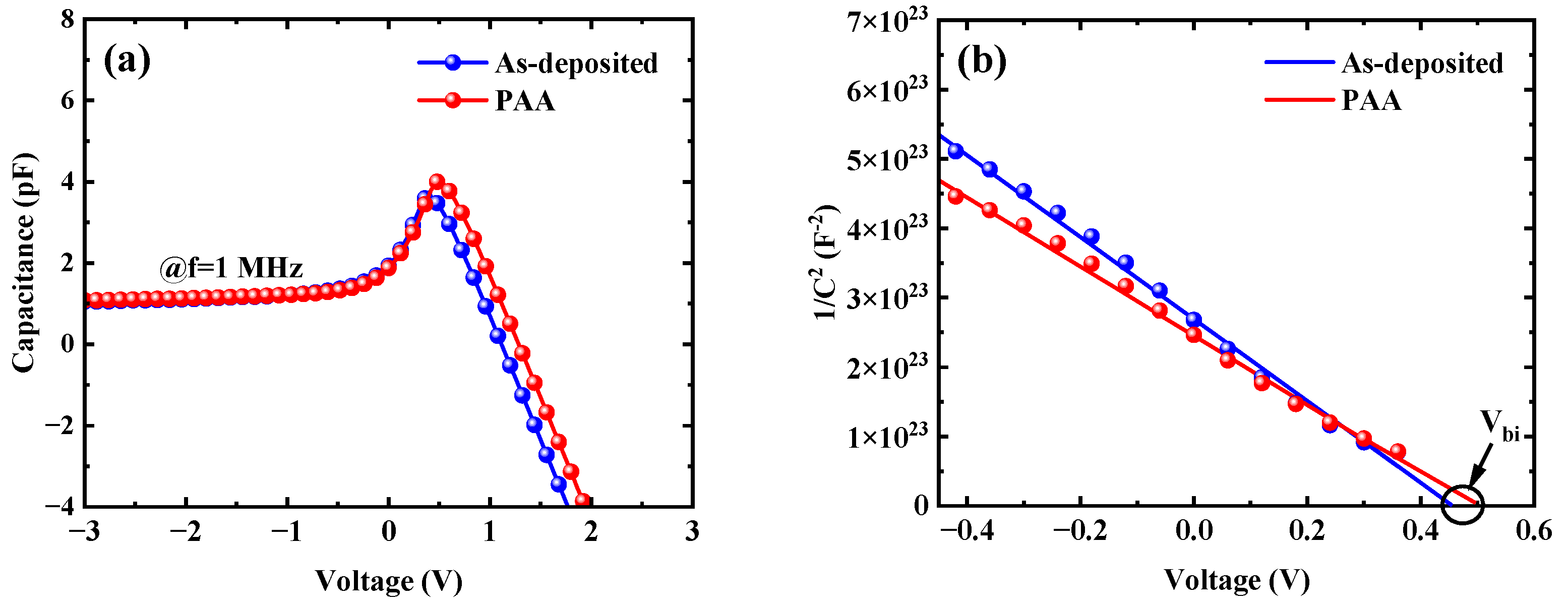

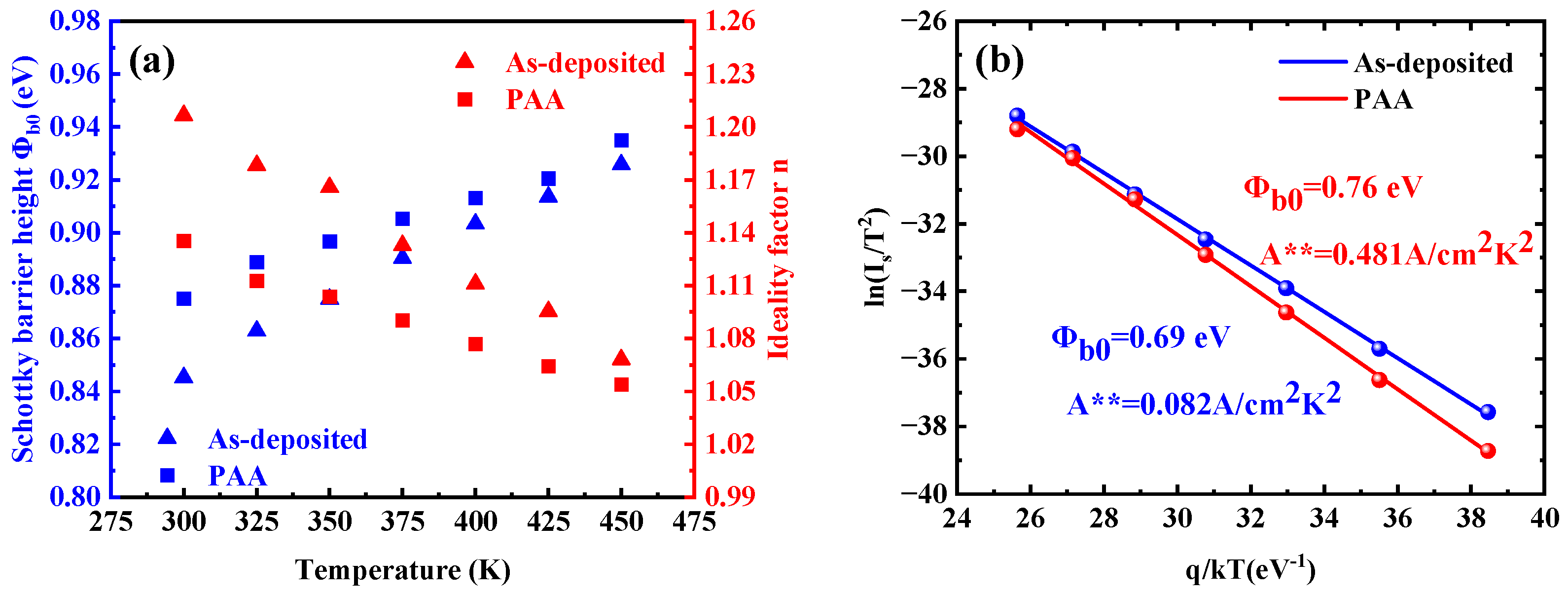

Disclaimer/Publisher’s Note: The statements, opinions and data contained in all publications are solely those of the individual author(s) and contributor(s) and not of MDPI and/or the editor(s). MDPI and/or the editor(s) disclaim responsibility for any injury to people or property resulting from any ideas, methods, instructions or products referred to in the content. |
© 2025 by the authors. Licensee MDPI, Basel, Switzerland. This article is an open access article distributed under the terms and conditions of the Creative Commons Attribution (CC BY) license (https://creativecommons.org/licenses/by/4.0/).
Share and Cite
Xie, L.; Zhang, T.; Xu, S.; Su, H.; Tao, H.; Gao, Y.; Liu, X.; Zhang, J.; Hao, Y. The Barrier Inhomogeneity and the Electrical Characteristics of W/Au β-Ga2O3 Schottky Barrier Diodes. Micromachines 2025, 16, 369. https://doi.org/10.3390/mi16040369
Xie L, Zhang T, Xu S, Su H, Tao H, Gao Y, Liu X, Zhang J, Hao Y. The Barrier Inhomogeneity and the Electrical Characteristics of W/Au β-Ga2O3 Schottky Barrier Diodes. Micromachines. 2025; 16(4):369. https://doi.org/10.3390/mi16040369
Chicago/Turabian StyleXie, Lei, Tao Zhang, Shengrui Xu, Huake Su, Hongchang Tao, Yuan Gao, Xu Liu, Jincheng Zhang, and Yue Hao. 2025. "The Barrier Inhomogeneity and the Electrical Characteristics of W/Au β-Ga2O3 Schottky Barrier Diodes" Micromachines 16, no. 4: 369. https://doi.org/10.3390/mi16040369
APA StyleXie, L., Zhang, T., Xu, S., Su, H., Tao, H., Gao, Y., Liu, X., Zhang, J., & Hao, Y. (2025). The Barrier Inhomogeneity and the Electrical Characteristics of W/Au β-Ga2O3 Schottky Barrier Diodes. Micromachines, 16(4), 369. https://doi.org/10.3390/mi16040369






